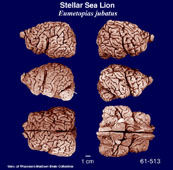|
Stellar
Sea Lion
(Eumetopias jubatus) #61-513 |
||||
|
| Physical
characteristics and distribution |
|
Adult
males of E. jubatus average about 300-325 cm in length
and 1,000-1,120 kg in weight; females average about 240 - 270
kg. in length with some individuals reaching 350 kg. This single
species exhibits pronounced sexual dimorphism, slightly variable
in color, ranging from light buff to reddish brown with the
chest and abdomen a little darker. Adult males develop a massive
neck and heavy, coarse mane. Females have 2-6 retractable mammae. Populations of E. jubatus have dropped sharply in recent years and the USDI has issued an emergency classification of threatened for this species. They can be found in the Northern Pacific coastal regions of Canada, China (vagrant populations to Jiangsu), Japan (from Hokkaido N), Russia, USA (Alaska, Washington, Oregon, California). |
|
Description
of the brain
|
|
Animal
source and preparation
|
|
All
specimens collected followed the same preparation
and histological procedure.
|
Other Related Resources (websites and publications)
List of Specimens | Explore Collections | Brain Sections | Brain Evolution | Brain Development | Brain Circuitry | Brain Functions | Location and Use | Related Web Sites | Contact Us | Search MSU Database | Personnel | Home



